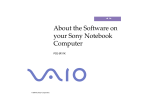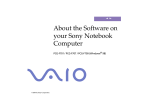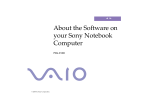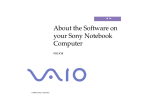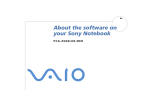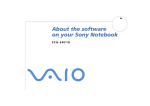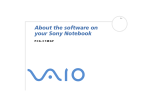Download PCG-C1VE - Sony Europe
Transcript
n N About the Software on your Sony Notebook Computer PCG-C1VE © 2000 by Sony Corporation. About the Software on your Notebook Computer n N 2 NOTICE This product contains software owned by Sony and licensed by third parties. Use of such software is subject to the terms and conditions of license agreements enclosed with this product. Software specifications are subject to change without notice and may not necessarily be identical to current retail versions. Updates and additions to software may require an additional charge. Subscriptions to online service providers may require a fee and credit card information. Financial services may require prior arrangements with participating financial institutions. © 2000 Sony Corporation All rights reserved. Reproduction in whole or in part without permission is prohibited. End User Software License Agreement This End User Software License Agreement (the "EULA") is a legal agreement between you and Sony Corporation (hereinafter referred to as "SONY"), a corporation organized under Japanese Law, the manufacturer of your SONY computer system (the "SONY HARDWARE"). Please read this EULA carefully before installing or using the software distributed together with this EULA (the "SONY SOFTWARE"). By installing or using the SONY SOFTWARE, you agree to be bound by the terms of this EULA. You may use the SONY SOFTWARE only in connection with the use of the SONY HARDWARE. SONY SOFTWARE is licensed not sold. Notwithstanding the foregoing, software distributed together with separate End User Software License Agreement (the "Third Party EULA"), including but not limited to Windows® operating system provided by Microsoft Corporation, shall be covered by the Third Party EULA. If you do not agree to the terms of this EULA, please return the SONY SOFTWARE together with the SONY HARDWARE to the place where you obtained it. 1. License. This SONY SOFTWARE and the related documentation are licensed to you by SONY. This EULA allows you to use the SONY SOFTWARE for your personal use for a single SONY HARDWARE outside a network and only to make one copy of the SONY SOFTWARE in machine-readable form for back-up purposes only. About the Software on your Notebook Computer n N 3 2. Restrictions. The SONY SOFTWARE contains copyrighted material and other proprietary material. In order to protect them, and except as permitted by applicable law, you may not decompile, reverse engineer or disassemble the SONY SOFTWARE in whole or in part. Except for the transfer of the SONY SOFTWARE together with the SONY HARDWARE and prior agreement of the recipient to be bound by the terms and conditions of this EULA, you may not sell or rent the SONY SOFTWARE and its copy to any third party. 3. Limited Warranty. SONY warrants the media on which the SONY SOFTWARE is recorded to be free from physical defects for a period of ninety (90) days from the date of purchase as evidenced by a copy of the receipt. During the applicable warranty period, SONY will replace free of charge such media that proved to be defective; provided they are returned properly packaged to the place where you obtained it, together with your name, address, and proof of date of purchase. SONY will have no responsibility to replace media damaged by accident, abuse, or misapplication. The above limited warranty replaces all other representations, conditions and warranties, whether express or implied, by statute or otherwise and SONY expressly disclaims all other warranties and all conditions including, but not limited to, the implied warranties and/or conditions of satisfactory quality and fitness for a particular purpose. The terms of this limited warranty do not affect or prejudice your statutory rights as an ultimate consumer, neither do they limit or exclude any liability for death or personal injury caused by the negligence of SONY. 4. Termination. This EULA is effective until terminated. You may terminate this EULA at any time by destroying the SONY SOFTWARE, related documentation, and all copies thereof. This EULA will terminate immediately without notice from SONY, if you fail to comply with any provision of this EULA. Upon termination you must destroy the SONY SOFTWARE, related documentation, and all copies thereof. 5. Governing Law. This EULA shall be governed by and construed in accordance with the laws of Japan. Should you have any questions concerning this EULA or this limited warranty, please refer to the Customer Service Guide on how to contact VAIO-Link. Sony, DVgate, i.LINKTM, JogDialTM, Mavica, PictureGear, Memory Stick and the Memory Stick logo, VAIO and the VAIO logo are trademarks of Sony Corporation. Windows, the Windows 98, the Windows Me and the Windows 2000 logos are registered trademarks of Microsoft Corporation. Transmeta, the Transmeta logo, Crusoe, the Crusoe logo, Code MorphingTM Software, LongRunTM Power Management and combinations thereof are trademarks of Transmeta Corporation in the USA and other countries. All other trademarks are trademarks of their respective owners. About the Software on your Notebook Computer n N 4 Specifications are subject to change without notice. As an ENERGY STAR Partner, Sony has determined that this product meets the ENERGY STAR guidelines for energy efficiency. The International ENERGY STAR Office Equipment Program is an international program that promotes energy saving through the use of computers and their office equipment. The program backs the development and dissemination of products with functions that effectively reduce energy consumption. It is an open system in which business proprietors can participate voluntarily. The targeted products are office equipment such as computers, displays, printers, facsimiles and copiers. Their standards and logos are uniform among participating nations. ENERGY STAR is a U.S. registered mark. About the Software on Your Notebook Computer n N 5 About the Software on your Notebook Computer Sony software About the Software on Your Notebook Computer Your Sony notebook computer is ready to help you work, play, learn, and communicate as soon as you turn it on. This section gives you an overview of the activities you can perform with your software titles. For general information and technical assistance, please refer to your Customer Service Guide. Sony software PictureGear Sony Electronics Create your own environment with the Digital Image Library (photos, backgrounds, wallpapers, slide shows, etc). PictureGear is your assistant for creating and implementing personal screen savers, panoramas (combined images)... You can even animate your preferred gifs with Gif Animation Tools, create labels for all your medias with PictureGear Label Maker, or play back movies in a variety of formats. For details, please read the PictureGear Help file. Jog Dial Utility Sony Electronics The Jog Dial Utility (VAIO Action Setup) allows you to configure the Jog Dial on your computer. In this application, you can select the Sony applications, or others, that you want the Jog Dial to pilot ; you can also configure the Jog Dial to start any application, establish a dialup connection, or read an e-mail , simply by turning and pressing the Jog Dial. Finally, the Jog Dial Utility allows you to configure your i.LINK connections, and to set a Timer that can launch any application at the time you select. See "Setting up the Jog Dial" and the Jog Dial Setup Help file for details. About the Software on Your Notebook Computer n N 6 About the Software on your Notebook Computer Sony software DVgate Sony Electronics DVgate is a kit of 3 complementary applications: DVgate Motion, DVgate Still, and DVgate Assemble. Edit the rushes you have shot with your digital video camera recorder using this video-capture application, specially tuned for high-quality numeric movies. When connected to your camera via i.LINKTM, your computer operates as an editing desk that can preview, cut and assemble your selection and save the sequences in AVI format. Attaching a DV device to the i.LINKTM connector enables you to transfer the images you have captured to your hard drive. DVgate Still displays digital video images sent from a digital video cassette recorder or a digital video camera recorder, and captures them as still pictures on your notebook computer. For details, please read the DVgate Help file. Media Bar Sony Electronics The Media Bar allows you to play audio and video files in various formats on your hard drive. Video images are displayed in a separate Movie window, which you can move and resize (to full screen). For details, please read the Media Bar Help file. CyberCode Finder Sony Electronics The CyberCode Finder is a Sony interface that provides you with task-relevant information in a clear and attractive manner. The CyberCodes, 2D bar codes developed by Sony, act as indexes and allow you to bring up the corresponding information on your computer, start registered software and documents as well as print your own CyberCodes. For further details, please refer to the CyberCode Finder Help file. About the Software on Your Notebook Computer n N 7 About the Software on your Notebook Computer Sony software Smart Capture Sony Electronics Your notebook computer features a built-in camera to shoot still images and video clips, which you can view, edit or send by e-mail. The Smart Capture Finder displays images from the camera and allows you to adjust the settings or create effects. Smart Capture enables you to capture images via i.LINK compatible devices or create a panorama picture using the MOTION EYE and the panorama assist function. See About the Software guide, Using Smart Capture on page 12 for more details or refer to the online help files. MovieShaker Sony Electronics MovieShaker® creates personal movies - complete with transitions, special effects, background music, and text. All you do is import your clips, pick the tone you want and MovieShaker® does the rest. You can also choose to take control and produce your very own movie. You choose the exact clips order, special effects, and transitions. You can also import your own music and MovieShaker® will automatically match the length of the song to the length of your movie. VisualFlow Sony Electronics VisualFlow allows you to browse interactively through the contents of your Memory Sticks (optional). VisualFlow can display Memory Stick files in a variety of ways, and allows you to play / display still images, movies or sound files within VisualFlow or with other software. VisualFlow is started by default when you insert a Memory Stick. You can change this setting in Vaio Action Setup. For details, please read the VisualFlow Help file. About the Software on Your Notebook Computer n N 8 About the Software on your Notebook Computer Sony software PowerPanel Sony Electronics The PowerPanel utility controls the power management of your notebook computer and provides key information about system activity and battery life. Automatic power management selects the most appropriate profile, depending on the application you’re working with and the conditions of use. See the "PowerPanel" chapter or the PowerPanel Help file for details. Sony Notebook Setup Sony Electronics Use the Sony Notebook Setup to confirm system information, specify preferences for system behavior, and change hardware settings for your Sony Notebook computer. For more information, read the help file of Sony Notebook Setup. UI Design Selector Sony Electronics You can change the window design of the Sony Software compatible with UI Design selector. Product Recovery CD-ROM Sony ITE The Product Recovery CD-ROM allows you to reinstall individual applications and device drivers if they are corrupted or accidentally erased. It also allows you to restore the software titles that were shipped with your computer if they become corrupted or are erased accidentally. Reinstalling an individual device driver or software title may correct a problem you are experiencing with your computer, and you may not need to recover the entire contents of your hard drive. ! You can only use this Recovery CD-ROM on the Sony notebook you purchased and not on any other Sony PC or other manufacturer's PC. About the Software on Your Notebook Computer n N 9 About the Software on your Notebook Computer Operating System and other pre-installed software Operating System and other pre-installed software Windows® Millennium Edition Microsoft Corporation Microsoft® Windows® Millennium Edition makes your computer work better by integrating tightly with the Internet and providing better system performance and easier system diagnostics and maintenance. With Windows® Millennium Edition, your system plays better as well with support for the latest graphics, sound, and multimedia technologies, easy addition and removal of peripheral devices, and the convergence of the TV and PC in your home. This exciting new operating system builds on the groundbreaking features introduced with Windows® 98. At the same time, Windows® Millennium Edition maintains the best support for older Windows-based applications and technologies. For questions and technical assistance, go online to: http://support.microsoft.com/directory/ Internet Explorer 5.5 Microsoft Corporation Internet Explorer is the Internet browser of Microsoft. The Setup Wizard configures your computer to connect automatically to the service provider of your choice. A full e-mail package enables you to send and receive mail - including attached files - across the Internet. NetMeeting, Outlook Express and Microsoft Chat are just some of the components bundled with Internet Explorer 5.5. A complete online tutorial helps new users become comfortable using the Internet. For questions and technical assistance, go online to: http://support.microsoft.com/directory/ About the Software on Your Notebook Computer n N 10 About the Software on your Notebook Computer Operating System and other pre-installed software Adobe® Acrobat® Reader 4.1 Adobe Systems Incorporated Acrobat Reader software allows you to view, navigate, and print electronic documents in Adobe Portable Document Format (PDF), an open file format that is intended to preserve the fidelity of documents created on all major computer platforms. Once Acrobat Reader is installed, you can open and view PDF files from within your Web browser by clicking on a PDF file embedded in an HTML file. You quickly see the first page while the rest of the document is being downloaded. For questions and technical assistance, go online at http://www.adobe.com QuickTime 4.1.2 Apple QuickTime is the Apple technology that makes video, sound, music, 3D and virtual reality come alive for your Internet browser and Windows. For further information, see the web site at: http://www.apple.com/quicktime/ RealPlayer 7.0 RealNetworks RealPlayer is the RealNetworks video and audio player which lets you access 2,500 radio stations featuring music, news and sports. For further information, see the web site at: http://www.real.com RealProducer 6.1 RealNetworks RealProducer is the streaming media authoring tool of RealNetworks: It lets you create audio and video for your Web pages. For further information, see the web site at: http://www.real.com About the Software on Your Notebook Computer n N 11 About the Software on your Notebook Computer Operating System and other pre-installed software VirusScan McAfee (Network Associates) VirusScan is McAfee's powerful and advanced anti-virus solution. If a virus is detected, VirusScan can attempt to remove it from the infected file, move the file to a quarantine location, or delete the infected file. VirusScan is an important element of a comprehensive security program that includes a variety of safety measures such as regular backups, meaningful password protection, training, and awareness. For details, please refer to the online help files or for technical support, go to http://www.mcafee.com Using Smart Utilities n N 12 About the Software on your Notebook Computer Using Smart Capture Using Smart Utilities Do not touch the camera lens. Do not point the camera towards the Sun. Doing so may cause damage to the camera. Using Smart Capture Your computer includes a built-in "MOTION EYE" camera. You can use the camera software to shoot still images and record video clips. Capturing a still image 1 Press the CAPTURE button. The Smart Capture application starts. 2 3 4 The finder window appears.Turn the MOTION EYE lens towards the subject. Adjust the focus ring. Half-press the CAPTURE button on the computer. The image remains still for a few seconds. To display another image, release the CAPTURE button and press again. Using Smart Utilities n N 13 About the Software on your Notebook Computer Using Smart Capture See the Smart Capture software online help for more information on installation and use. 5 Fully press the CAPTURE button. The Still Viewer window will open and the captured still image appears in the Still Viewer window. You can capture the following still images sizes : 640 x 480, 320 x 240, 160 x 120 and 80 x 60 pixels. Captured still image When capturing a small resolution image (i.e. 80 x 60 pixels) , the displayed image on the finder window may appear blurred. A gap may appear when a rapidmoving object is displayed. However this is not a malfunction. If you turn the lens inwards, Smart Capture goes into mirror mode. You can use the mirror mode, to take a video clip of yourself. A mirror-image appears in the finder window of the display while shooting, however, after capturing a normal image appears. 6 To end Smart Capture click the button in the top right corner of the window. Using Smart Utilities n N 14 About the Software on your Notebook Computer Displaying the captured images in Still Viewer You can create a panorama picture by using PictureGear 2.5SE or higher. Displaying the captured images in Still Viewer From the Start menu, select Programs, Smart Capture and click Still Viewer. You can display, save or delete your images or send them by e-mail. See the software online help for information on installation and use. You can capture still images and video clips from a digital video camera using Smart Capture. When you run applications used by the built-in camera, set the power management profile in PowerPanel to AC Profile or Camera. To end Still Viewer click the button. Using Smart Utilities n N 15 About the Software on your Notebook Computer To send a still image via e-mail You need to set up MAPI when using the e-mail software. See the manual supplied with the e-mail software for more information on sending e-mails. To send a still image via e-mail 1 2 3 4 5 Click the Start button on the Windows® taskbar. Point to Programs and click Smart Capture. Click Still Viewer. Select the still image you want to send via e-mail, using or . Click MAIL. Your e-mail window will appear with the selected file attached to your message. Still image selected Using Smart Utilities n N 16 About the Software on your Notebook Computer Shooting a video clip Shooting a video clip You can use the MOTION EYE to shoot (capture) video clips, as well as play them or send them via e-mail (if you selected NET MOVIE in the Smart Capture window) 1 2 Press the CAPTURE button. The Smart Capture window will appear. Select Still Viewer/Movie Player in the application switch list. Then select LONG MOVIE or NET MOVIE using the Switch Capture Mode Button. Click here 3 4 5 Adjust using the focus ring. Turn the MOTION EYE lens towards the subject. Keep pressing the CAPTURE button to shoot a video clip. You can shoot up to 60 seconds (if you select NET MOVIE). Using Smart Utilities n N 17 About the Software on your Notebook Computer Shooting a video clip 6 Release the CAPTURE button when finished. The Movie Player window opens up and the captured video clip appears in the Movie Player window. Click B to playback the images. Click X to pause, x to stop playback. To end Smart Capture, click Captured video clip Using Smart Utilities n N 18 About the Software on your Notebook Computer Capture modes You can adjust the refresh rate when you select Monitor as the display mode. Some displays do not support using both the computer’s LCD and an external display simultaneously. To use the Monitor and Monitor/LCD display modes, an external display must be connected to the VGA Out connector via a display adapter. Capture modes Extended Record Mode Video: Motion JPEG, 640x480, maximum of 15 frames/second or Motion JPEG 320x240, 24 bit, maximum of 30 frames/second. Audio: PCM, 22.05 kHz, 16 bit, monophonic. NET MOVIE Mode Video: 160x120, 24 bit, maximum of 10 frames/second Audio: PCM, 11.025 kHz, 16 bit, monophonic. MPEG1 Format Video: MPEG1, 160x112, maximum of 10 frames/second (equivalent). Audio: MPEG1, monophonic, 11.025 kHz(equivalent). Using Smart Utilities n N About the Software on your Notebook Computer To playback captured video clips To playback captured video clips 1 2 3 Start the Movie Player software. Click B to playback the images. Click X to pause, x to stop playback. To end Movie Player click . 19 Using Smart Utilities n N About the Software on your Notebook Computer Using Smart Capture See the manual supplied with the e-mail software for more information on sending e-mails. Before shooting a video clip, you can access the Recording Options by clicking the Options button in the Smart Capture window. This dialog box allows you to choose the desired compression rate by moving the slider. To send a video clip via e-mail If you shoot a video clip in NET MOVIE mode, you can send it by e-mail. 1 2 3 4 Click the Start button on the Windows® taskbar. 5 Send the e-mail. Point to Programs and then Smart Capture. Click Movie Player. Click MAIL. 20 About the Software on your Notebook Computer Customizing Your Notebook Computer n N 21 Customizing Your Notebook Computer The following sections briefly describe how to change the main settings of your notebook computer. Among other things, you will learn how to prepare your modem for use, how to use and customize the look of your Sony software and utilities, and you will be introduced to the different display modes. For more detailed information, you can also refer to the Help systems of the software. Customizing Your Notebook Computer n N 22 About the Software on your Notebook Computer Setting up Jog Dial Setting up Jog Dial The VAIO Action Setup software enables you to start your favorite software with the Jog Dial. This section briefly describes how to use VAIO Action Setup. You can also refer to the VAIO Action Setup Help for more detailed information. Defining the Jog Dial settings You can select the rotation direction, allocate functions to software that do not support the Jog Dial, or select the sound effects while using the Jog Dial, etc. 1 2 Click Setup in the Jog Dial window to display the Vaio Action Setup window. The Jog Dial pane is opened by default. Customizing Your Notebook Computer n N 23 About the Software on your Notebook Computer Setting up Jog Dial 3 In the Advanced Setting 1 tab, set the Jog Dial's scroll direction and the turning direction of the Jog Dial window by selecting the Upward or Downward option buttons. 4 In the Advanced Setting 2 tab, define whether the window should only be shown while using the Jog Dial control. Select the Show Jog Dial only when in use option button, if the window should be shown only while using the Jog Dial control and enter the display time in the box underneath. Do not select the check box to see the window at all times. 5 In the Sound Setting tab define the sound effect associated with the Jog Dial functionality. Select the Use sound when turning check box to hear a sound when turning the Jog Dial and enter the path and file name of the sound in the text box underneath. Select the Use sound when pressing check box to hear a sound when pressing the Jog Dial and enter the path and file name of the sound in the text box underneath. 6 In the Application List allocate functions to software that do not support the Jog Dial. Click the Create Folder button to define a new software folder. Click the Add, Replace, Delete buttons to add, replace or delete a function in one of the software folders. Customizing Your Notebook Computer n N 24 About the Software on your Notebook Computer Setting up Jog Dial Information on Using the Jog Dial The following functions are preinstalled in the Jog Dial launcher. Name Description VAIO Web Press the Jog Dial to go to the VAIO home page VAIO-Link Press the Jog Dial to go to the VAIO-Link home page Club VAIO Press the Jog Dial to go to the Club VAIO home page Suspend/Hibernation Press the Jog Dial to select a power saving mode. See "Controlling Power Management" for more information. Monitor Press the Jog Dial to toggle through the computer display and the LCD. Only LCD / LCD and external display / only external Display g only LCD... TV output/ LCD Press the Jog Dial to toggle through the external display connected to your computer and the LCD. Only LCD / LCD and external display / only LCD... Brightness Turn the Jog Dial to adjust the brightness of the LCD screen. Press the Jog Dial to confirm the adjustment. Volume Turn the Jog Dial to adjust the volume of the internal speakers. Mute Press the Jog Dial to mute the volume of the internal speakers. Bass Boost Press the Jog Dial to increase the basses on your headphones. Customizing Your Notebook Computer n N 25 About the Software on your Notebook Computer Sony Notebook Setup Sony Notebook Setup To display the Sony Notebook Setup screen: 1 2 3 4 Click the Start button on the Windows® taskbar. In Programs, select Sony Notebook Setup. The Basic window appears; you can then enhance the features by clicking the Basic / Advanced tab. Select the tab for the item you want to change. After you finish, click OK. Customizing Your Notebook Computer n N 26 About the Software on your Notebook Computer Sony Notebook Setup For more information about each option, click Help on the Notebook Setup screen to display the help file. Notebook Setup Tabs Tab Description About This Computer Display system information, including memory capacity, serial number, and BIOS version. Initial Setting Select the drive and device order you wish to use for loading the operating system. You can specify the hard drive as well as other drives inserted into your computer. Power On Password This dialog box allows you to register a password with which to control access to your VAIO Notebook. Bass Boost This dialog box allows you to set the Bass Boost option on/off and experience the effect by playing back a sample sound. Basic/Advanced Toggle between Advanced mode (additional screens with advanced settings) and Basic mode of display. Advanced mode includes Serial, Infrared and View Resources tabs. Customizing Your Notebook Computer n N 27 About the Software on your Notebook Computer PowerPanel When you use the battery pack as power source, your system selects the Maximum Battery Life power management profile by default. If you select a different power management profile while using battery power, the same profile will be automatically selected the next time you use the battery pack to power your computer. PowerPanel Controlling Power Management The PowerPanel utility controls the power management of your notebook computer and provides key information about system activity and battery life. The automatic power management selects the most advantageous profiles, or lets you customize the profiles you choose, according to your own needs, with the goal of extended battery life. PowerPanel main features Automatic Profile Selection (APS) based on the currently active application Ability to select special Power Profiles manually from the menu Ability to edit and create new profiles Ability to display detailed battery information CPU performance monitoring tool Works in harmony with Windows settings. To activate PowerPanel When you start the computer, the PowerPanel Battery status icon appears in the task tray by default. 1 2 You can select a power profile from the menu or a Power Management profile by right-clicking this icon. You can use the PowerPanel toolbars as well: Right-click the task bar at the bottom of the screen. Select Toolbars from the shortcut menu, then click Power Management or Battery Information. Customizing Your Notebook Computer n N 28 About the Software on your Notebook Computer PowerPanel 3 Depending on your choice, the Power Management or the Battery Information appears on the task bar ( you can change it into a floating window by dragging and dropping it on your desktop). 4 Click the button you want to set or view the Battery Information displayed on the task bar. Battery Information You can display detailed information for the battery used in your computer. The following section briefly describes how to display your computer’s general battery information. You can also refer to the PowerPanel Help for more detailed information. Displaying Detailed Battery Information You can obtain detailed information about the battery. Double-click the battery icon on the task tray to display detailed battery information. The screen appears displaying the Battery Tab, which contains information such as the estimated time-to-empty and charging time. Customizing Your Notebook Computer About the Software on your Notebook Computer PowerPanel Battery Icon Description Battery icon Battery status Discharging Fully charged Charging No battery n N 29 Customizing Your Notebook Computer n N 30 About the Software on your Notebook Computer PowerPanel CPU Information The PowerPanel utility allows you to monitor the performance of the CPU used in your computer. Here is a brief description on how to display your computer’s CPU information. To activate the CPU performance monitoring tools 1 2 Select the PowerPanel menu by right-clicking the PowerPanel icon in the task tray. 3 Double-click the CPU information icon. The CPU Information dialog box opens up. Make sure the Show CPU Status Icon option is checked. If this is the case, a CPU information icon should be displayed in the task tray. Customizing Your Notebook Computer n N 31 About the Software on your Notebook Computer PowerPanel Power Management Profiles PowerPanel provides several predefined power management profiles. Each profile consists of a group of specific power management settings that are designed to meet specific power management goals, ranging from maximum power management to no power management. Main preset profiles Icon Description Maximum Battery Life – Provides power saving features to give you maximum battery life and good performance. It reduces the brightness of the display and puts it into System Suspend mode after a specified time period. Ultimate Battery Life – Extends the Maximum Battery Life by disabling ports such as the i.LINK port. Maximum Performance – Provides the best system performance while still conserving power. AC Power – The power management state when AC power is in use. PowerPanel automatically loads the AC profile unless you disable this feature. Power Management Off – Turns off all power management features such as System Suspend and Hibernation modes. Camera – Optimizes performance and power requirements for camera usage. Customizing Your Notebook Computer n N 32 About the Software on your Notebook Computer PowerPanel Other preset profiles Icon Description Automatic Profile Selection – Analyses the performance of each application you choose and matches the profiles to its needs. Word Processing – Optimizes power management with longer timeouts on the hard disk and display screen. You can also establish settings for LCD (Video) Standby, Hard Disk Standby, and System Suspend to optimize power management for your system. Spreadsheet – Reduces the LCD brightness to “medium”, as your software doesn’t require higher performance. The sleep timer is activated. Presentation – Keeps the display on at all times while it conserves power. This option is ideal for slide show presentations. You can establish settings for LCD (Video) Standby, Hard Disk Standby, and System Suspend to optimize power management for your system. Communications – Extends battery life by initiating a quick display time-out. You can also establish settings for LCD (Video) Standby, Hard Disk Standby, and System Suspend to optimize power management for your system. Games – Disables the display and the Hard Disk Spindle Down timer. Customizing Your Notebook Computer n N 33 About the Software on your Notebook Computer PowerPanel Power Management Commands PowerPanel provides power management commands that you can use to activate specific power management functions and to control power for a specific device. You might use these commands when you want to override a profile setting or initiate an immediate action, such as putting the system into Video Standby mode before the Video Standby timer expires. Icon Description System Suspend – Puts the system into System Suspend mode, a power management state that saves the state of the system and peripheral devices in memory (RAM). Power consumption reduces to a minimum, and the system remains on. To return the system to the active state, press any key or the power switch on your computer. System Hibernation – Provides for the lowest level of power consumption. The system writes the state of the system and peripheral devices to the hard disk and turns off the system power. To return the system to the original state, use the power switch to turn on power. LCD (Video) Standby – Turns off the LCD to save power. If you turn off the Video Standby timer, the display remains active except when the system enters System Suspend mode. The video display system is one of the largest consumers of power in the system. Customizing Your Notebook Computer n N 34 About the Software on your Notebook Computer PowerPanel Automatic Profiles Selection (APS) A Power Profile is a set of timer values for a variety of system devices. PowerPanel automatically selects the profile associated with the application you are using and changes profiles as you switch between applications. The Power Management lets your system enter energy saving modes by levelling some energy consuming parameters, such as LCD brightness, or hard disk activity. Choosing Automatic Profiles By right-clicking the PowerPanel icon on the task tray, you can choose Automatic Profile Selection: this automatically enables PowerPanel to set the power management settings: Customizing Your Notebook Computer n N 35 About the Software on your Notebook Computer PowerPanel Customizing PowerPanel You can customize the PowerPanel toolbar to suit your portable computing needs. You can edit the pre-defined Power Management settings, create new profiles and modify the alarm settings. Please refer to PowerPanel Help for more information. Customizing Your Notebook Computer n N 36 About the Software on your Notebook Computer Selecting the Display mode If you cannot see the movie or DVD on the external display, set the external display to Primary by proceeding as follows: Select the Displays tab and uncheck the Monitor or TV bottom left button to change it from Secondary to Primary. Depending on the type of external display and projector you are using, you may not be able to display the computer LCD simultaneously. Selecting the Display mode This notebook computer uses the ATI video controller. You can select which display is used when the computer is connected to an external display. 1 2 3 4 5 6 7 8 Click the Start button, select Settings and then click Control Panel. The Control Panel appears. Double-click Display. The Display Properties dialog box appears. Click the Settings tab. Click the Advanced button. The Rage Mobility-M1 PCI dialog box appears. Click the Displays tab to set the display settings. For details, click the Help button on the bottom right. Customizing Your Notebook Computer n N 37 About the Software on your Notebook Computer Using the Dual Display Function Certain software may not be compatible with Dual Display settings. Make sure that your computer does not enter System Suspend mode or System Hibernation mode while you are using Dual Display mode, otherwise your computer may not return to Normal mode. If you set different colours on each display, do not divide one single window on two displays, otherwise your software may not work properly. With software using Motion Eye such as Smart Capture, the picture may not be displayed properly. Set fewer colours or a lower resolution for each display. Using the Dual Display Function The dual display function allows you to distribute portions of your desktop across separate displays. For example, if you have an external monitor attached to the monitor connector, your LCD display and the monitor can function as a single desktop. You can move the cursor off one display and onto the other. This allows you to drag objects, such as an open application window or a toolbar, from one display to the other. This configuration of a single desktop distributed across separate displays is referred to as a virtual desktop. Virtual desktop External monitor Your LCD display Customizing Your Notebook Computer n N 38 About the Software on your Notebook Computer Using the Dual Display Function Selecting dual display mode 1 2 3 4 5 Click the Start button on the Windows® taskbar. Point to Settings and click Control Panel. Click the Display icon. Click the Settings tab. Click the display marked ‘2’ and click Yes. Setting the colors and resolution for each display You can set the display colors and resolution for each display that is part of a virtual desktop. Follow steps 1 to 4 above to display the Display Properties dialog box. Select the display you wish to change (1 or 2) by clicking on it. You can change colors by selecting an option from the Color list. Use the slider in the Brightness area to adjust it to your own needs. Click OK or Apply. Click OK to confirm that you want to make the changes. Customizing the virtual desktop You can customize dual display mode by changing the position of the two desktops comprising the virtual desktop. In the Display Properties dialog box, drag the icons of display 1 or display 2, moving them to a new position relatively to each other. The two display icons must be connected to create a virtual desktop. Click OK to apply the change. Deactivating the dual display setting Follow the same steps as in the section Selecting dual display mode above. When you reach step 4, click with the right mouse button and select Disabled. This will disable the dual display. About the Software on your Notebook Computer Using the Product Recovery CD-ROMs Supplied (depending on the model): 1 CD-ROM with both application and system recovery data or 2 CD-ROMs (one application and one system recovery CD). You can only use these Recovery CD-ROMs on the Sony notebook you purchased and not on any other Sony PC or other manufacturer's PC! Your need to connect an optional CD-ROM drive (for more details, refer to the Compatibility Table in your User Guide). Read the manual supplied with your optional CD-ROM Drive carefully before using it for recovery purposes. n N 39 Using the Product Recovery CD-ROMs The following sections describe how to use the Recovery CD-ROMs. You will find a set of two Recovery CD-ROMs in your Product Recovery Pack: The System Recovery CD-ROM (vol. 1 of 2) allows you to perform a full system recovery; The Application Recovery CD-ROM (vol. 2 of 2) helps you to recover your preinstalled software and to reinstall the device drivers manually. The system recovery process allows you to reinstall an image of the hard disk as it was when you started using your notebook computer. Use the System Recovery CD in the following cases: In the event of a serious system crash, If you want to modify the size of your partitions. The Application Recovery CD allows you to: Reinstall an individual driver if a device is not functioning properly, Reinstall an individual application in the case you have problems running it. About the Software on your Notebook Computer Using the Product Recovery CD-ROMs n N 40 Performing a system recovery Use this option only when your system is seriously damaged, e.g. if Windows® does not work any more, or your PC behaves abnormally, etc. The system recovery will completely reinstall the originally configured system on your C: drive. Your D: drive data will not be deleted if you choose to keep the same partition settings. If you decide to modify the size of your partitions, the existing data on both drives (C: and D:) will be deleted. ! Applying a system recovery means that you will lose all your data stored on your C: drive (and your D: drive if you modify partition settings). Therefore, before applying a system recovery, copy your data to an external disk. ! CAUTION: make sure that your computer is connected to AC (not the battery) before you attempt a system recovery. ! CAUTION: when the recovery is performed, you must remove the recovery CD-ROM from the drive before restarting the computer. The recovery process takes between 10 to 20 minutes to complete. You must run the Application Recovery CD (vol. 2 of 2) from Windows®. The application will not run from DOS. When performing an application recovery, you do not lose data on your hard disk. When performing a system recovery, you have the choice between a Standard Recovery and an Advanced Recovery. When choosing a Standard Recovery, you leave the current partition sizes untouched. When choosing an Advanced Recovery, you can adapt the partition sizes. About the Software on your Notebook Computer Using the Product Recovery CD-ROMs n N 41 Procedure for starting a Standard System Recovery 1 2 Take the System Recovery CD-ROM (vol. 1 of 2). 3 4 5 6 Shut down your computer (Start/Shut Down/Shut Down). Turn on your computer (using AC power only) and insert the System Recovery CD-ROM in the CD-ROM drive. Wait ten seconds and turn your computer back on. On the first screen that appears, press S (Standard). The System Recovery CD screen appears, asking you if you are really sure you want to continue. Click Y (Yes). You will be asked again whether you are really sure. Confirm. Procedure for starting an Advanced System Recovery 1 2 Take the System Recovery CD-ROM (vol. 1 of 2). 3 4 5 6 Shut down your computer (Start/Shut Down/Shut Down). Turn on your computer (using AC power only) and insert the System Recovery CD-ROM in the CD-ROM drive. Wait ten seconds and turn your computer back on. On the first screen that appears, press A (Advanced). The System Recovery CD screen appears, asking you what to do with the partitions on your hard disk. At this stage you have 3 options available. Recovering the system without changing partitions Recovering the system with modified partition sizes Aborting the recovery process About the Software on your Notebook Computer Using the Product Recovery CD-ROMs n N 42 Recovering the system without changing partitions 1 Press C to keep your current partitions. This is the recommended option if you do not need to modify the partition sizes and if you want to restore your C: drive while keeping the data on your D: drive untouched. 2 3 4 Press G to proceed with the system recovery. Follow the instructions on the screen. When the recovery process is finished, remove the Recovery CD-ROM from the drive and press any key to restart your notebook computer. Recovering the system with modified partition sizes 1 Press P to modify partitions on your notebook computer. Select this option only if you need change the sizes of your partitions. Please note that this option will delete all existing data both on the C: and D: drives before starting the recovery. 2 3 On the next screen, press Y to confirm the deletion of the current partitions. 4 Confirm your selection on the next screen and wait until the new partitions are created and the notebook computer reboots. 5 Then follow the steps described in the previous section Recovering the system without changing partitions. The next screen displays a selection of sizes for your new C: drive. According to the option you select, the recovery process will create 1 or 2 partitions on the hard disk. (For more details on partitions, see the chapter About the Partitions of your Hard Disk Drive) About the Software on your Notebook Computer Using the Product Recovery CD-ROMs n N 43 Aborting the recovery process The recovery process always warns you when the decision you are asked to take cannot be undone. Whenever possible, the recovery screens allow you either to go back to the previous screen, or to abort the recovery process. If your computer does not start the system recovery utility. Please refer to your Customer Service Guide to contact VAIO-Link. Using the Product Recovery CD-ROMs n N 44 About the Software on your Notebook Computer Performing an Application Recovery Performing an Application Recovery The application recovery utility allows you to reinstall individual applications. Reinstalling a program can fix the problems encountered if it does not run correctly anymore. Procedure for an application recovery 1 2 Take the Application Recovery CD-ROM (vol. 2 of 2). 3 Insert the Application Recovery CD-ROM in the CD-ROM drive. The Install Manager starts running automatically. 4 When the Install Manager menu appears, follow the instructions on the screen to select the application you want to recover. 5 Follow the installation instructions in the Install Manager. Turn on your computer (using AC power only) and wait until Windows® has loaded. Using the Product Recovery CD-ROMs n N 45 About the Software on your Notebook Computer Reinstalling a device driver Reinstalling a device driver Some applications or peripherals require specific drivers which you won’t find in the Windows® drivers folder. To help you find or restore typical drivers needed by your pre-installed applications, you can use the Application Recovery CD-ROM. 1 First check whether the driver you plan to reinstall is on the Application Recovery CD-ROM. Only device drivers that are not delivered with Windows® can be found in the Drivers directory. 2 3 Check all underlying sub-directories for the appropriate driver. Next, launch the Add New Hardware wizard (in the Windows® start menu, select Settings, then Control Panel, then View all Control Panel options if all options are not displayed) to install the appropriate device by browsing through the appropriate folders. About the Partitions of your Hard Disk Drive n N 46 About the Software on your Notebook Computer Default disk space allocation About the Partitions of your Hard Disk Drive In My Computer or Windows Explorer, you may have noticed the My Computer availability of two drives (C: and D:): your hard disk drive comes from the factory with 2 logical partitions: this does not mean that your computer contains two physical hard disks. Default disk space allocation When you start using your notebook computer, your C: drive contains all the files required by Windows and other pre-installed software, while the D: drive comes empty. The D: drive is the ideal storage space for all your documents, especially big ones like digital motion pictures captured with DVgate. About the Partitions of your Hard Disk Drive n N 47 About the Software on your Notebook Computer How to use your partitioned drives How to use your partitioned drives In order to avoid mishandling or malfunction of your software and files, please take the following precautions: To optimize data storage, use the C: drive to install new applications, and save all your documents to the D: drive. Moreover, doing so will prevent the loss of your documents in the case you need to perform a system recovery. Do not try to add, delete, or resize partitions unless you really need it. Changing partition settings might delete all your files on the hard disk. If you need to perform a system recovery, but do not want to loose all the data stored on your hard disk, copy all the files you want to keep on the D: drive. During the system recovery process, choose to keep the current partition information. Doing so will keep your D: drive unchanged after the recovery process. For more information on the recovery process, see the Using the Product Recovery CD-ROMs chapter. If you do need to change the size of your partitions, you can do so by performing a system recovery. In this case, it is important to note that all data on your hard disk will be deleted. If you need to keep existing files, be sure to backup them up before performing the system recovery. For more information on the recovery process, see the Using the Product Recovery CD-ROMs chapter. SID


















































